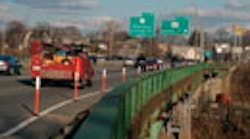The Reason Foundation’s 19th Annual Highway Report provides a mixed bag of good and poor ratings for American roadways on a state-by-state basis, with reductions in congestion and fatalities offset by uneven cost-effective management. But nationally, the group did find big improvements are being made.
Based on 2008 data, the study determined that bridges are in their best condition as a group since 1984, with highway pavement in its best condition since 1993. Traffic congestion is at its lowest since 2000, according to the analysis, with fatalities down to levels not seen since the 1960s.
However, the think tank pointed out that the economic recession is partly responsible for some of those improvements as people are driving less, helping to slow pavement deterioration while reducing traffic congestion and fatalities.
In terms of highway “cost effectiveness,” though, the record is more uneven. According to the study, North Dakota, Montana and Kansas manage the most cost-effective state highway systems, while Rhode Island, Alaska, California, Hawaii and New York maintain the least cost-effective networks.
New Jersey still spends dramatically more than every other state on highways, the report found, plunking down $1.1 million per mile on state roads. The second biggest spender, Florida, spends $671,000 per mile, with California laying out $545,000 per mile. South Carolina, by contrast, recorded the lowest expenses, spending just $34,000 per mile.
California also ssends a massive amount of transportation money that never makes it onto roads, the Reason Foundation said, spending $93,464 on administrative costs for every mile of state road. New York ($89,194 per mile), Massachusetts ($71,982), and New Jersey ($62,748) also compare poorly to states like Texas ($6,529) and Virginia ($6,370), which spend dramatically less on administrative costs.
Rhode Island has the most troubled bridges in the country, with over 53% of its bridges deficient or functionally obsolete, the study found. For comparison, just 10% of top-ranked Nevada’s bridges are rated deficient. Overall, more than 141,000 (23.7%) of America’s bridges were structurally deficient or functionally obsolete in 2008 – the lowest percentage since 1984.
Drivers in California, Minnesota, Maryland, Michigan and Connecticut are stuck in the worst traffic, according to the Reason Foundation research, with over 65% of all urban interstates congested in each of those five states.
However, nationally, the percentage of urban interstates that are congested fell below 50% for the first time since 2000, when congestion standards were revised.
In terms of highway safety, Massachusetts is at the top of the list with just 0.67 fatalities per 100 million miles driven. By contrast, Montana and Louisiana have the highest fatality rates, with 2.12 and 2.02 fatalities per million miles driven, respectively.
Motorists in California and Hawaii have to look out for the most potholes on urban Interstates, the study found, with 25% of urban highway pavement in poor condition in those two states. Alaska and Rhode Island have the bumpiest rural pavement, each with about 10% in poor condition.
However, as noted earlier, on a national basis pavement conditions on urban interstates are the best they’ve been since 1993, with rural primary roads the smoothest they’ve been since 1993 as well, noted the report’s primary author, David Hartgen, emeritus professor of transportation studies at the University of North Carolina at Charlotte.
“We’re seeing several factors combine to produce significant improvement in highway conditions,” he explained. Hartgen noted in particular that states invested a lot more money to improve pavement and bridges over the last few years, with spending increasing 8% from 2007 to 2008, and per-mile spending on state roads almost tripling since 1984.
“The significant reduction in vehicle miles traveled during the recession has also played a role in slowing system decay,” he added. “But as the states deal with large budget deficits and the recession continues, we’ll have to wait and see if this progress can be continued.”



